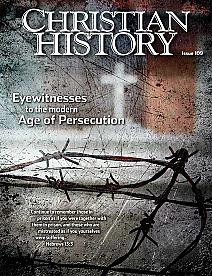Don Carlos de Seso Died for the Gospel in Spain
DON CARLOS DE SESO was not a typical martyr. Noblemen in Spain did not usually become Protestant converts. Known for his dignity of character, the Italian De Seso served Emperor Charles V with distinction and married a Spanish noblewoman. His imperial duties brought him into contact with Lutherans during his travels, who converted him to their thinking. Upon his return to Spain, he led hundreds around Valladolid into Lutheranism.
De Seso and a fellow worker, Domingo de Roxas, were betrayed and tried to escape. Captured in Navarre, they were brought back to Valladolid and subjected to the inquisition. Told that he must die, De Seso asked for paper so that he could write a confession. Here he penned a firm declaration of his Lutheran faith and a rejection of the doctrine of purgatory: “I believe that there is no other purgatory than the blood of Jesus Christ.”
King Philip II of Spain, hearing of the Protestant inroads in Spain, cut short a visit to the Netherlands where he was dealing with a general uprising provoked by his cruelty. Pope Paul IV and Philip II each issued harsh orders to stamp out the Lutheran “heresy” in Spain. Upon the King’s return, the Inquisition put on a great auto da fé (literally “act of faith,” a public ceremony where heretics were paraded, sentenced, and executed) at Valladolid on this day, 8 October 1559, with Philip as guest of honor. De Seso and twelve other people, a corpse, and an effigy (image) were to burn. The corpse was of a woman who had slit her own throat with scissors rather than die by fire.
Two men had to prop up forty-three year old De Seso when he was sentenced, so weak had fifteen months of imprisonment and torture left him. When he was led past Philip, he exclaimed, “Is it thus that you allow innocent subjects to be persecuted?” Philip’s response was, “If it were my own son, I would fetch the wood to burn him, were he such a wretch as you are!”
At the stakes, in dread of the flames, all but two of the victims made confession to the priests. Lutherans did not accept that a priest could absolve sins. By confessing, these people were not recanting, but were retreating from a principle of Lutheran teaching. Because of this, they were strangled before being burned. De Seso however, refused to make a confession, which he felt would be equivalent to saying the Inquisition had been right all along. When the flames rose slowly around him, he called on the soldiers to heap up more fuel. Seeing how bravely De Seso died, De Roxas shouted to the king that he was dying for the true faith—that of Luther. The king ordered him gagged. A clip of wood was forced onto his tongue, causing him agony. In the end he, too, confessed in order to die by strangling. One other victim, Juan Sánchez, inspired by De Seso’s bravery, refused confession and consequently was burned alive.
—Dan Graves
----------------
Learn more about persecution of Christians in Christian History #109, Eyewitnesses to the Modern Age of Persecution
For a deeper understanding of the Reformation period, get the Reformation 9-Pack (nine issues of Christian History magazine covering the Reformation)
and the Reformation Set of Nine (DVDs)
This Changed Everything, a look at the Reformation and what followed, can be streamed at RedeemTV as can other Reformation videos.








